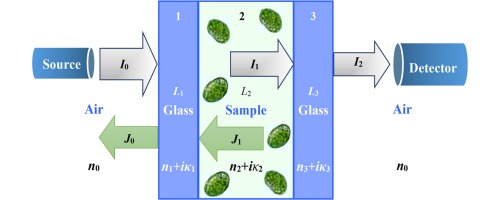Particuology ( IF 4.1 ) Pub Date : 2017-01-24 , DOI: 10.1016/j.partic.2016.08.004 Xingcan Li , Junming Zhao , Linhua Liu , Lin Zhang

|
The optical extinction characteristics of the three kinds of microalgae Nannochloropsis maritima, Ellipsoidion sp. (277.03), and Dunaliella tertiolecta were determined using an improved transmission method, in the 300–1800 nm spectral range. These three microalgae are promising candidates for the production of biofuels such as bio-hydrogen and biodiesel. The improved transmission method determines the spectral extinction coefficient of the microalgae. This is based on the measured transmittance, and employs an optical model that takes into consideration multiple reflections and refractions at the air–glass and glass–liquid interfaces. Silicon dioxide microspheres of monodisperse size were used as a model to verify the proposed method. The optical constants of the culture medium, size distributions, and extinction cross-sections of the microalgae cells were measured and analyzed. The improved transmission method is demonstrated to yield more accurate results than the traditional method. The spectral extinction efficiencies of the three kinds of microalgae show significant differences in the near ultraviolet and visible spectral regions. The spectral extinction efficiencies also exhibit small differences in the longer wavelength range of 950–1800 nm, with values generally less than 1.0. The measured extinction characteristics data of the three microalgae and the presented measurement method will facilitate process modeling in photobioreactors for biofuel production.
中文翻译:

改进透射法确定三种生物燃料微藻的消光特性
三种微藻Nannochloropsis maritima,Ellipsoidion sp。的消光特性。(277.03)和杜氏杜氏藻在300–1800 nm光谱范围内使用改进的透射法确定了这些元素。这三种微藻是生产生物燃料(如生物氢和生物柴油)的有前途的候选者。改进的透射法确定了微藻的光谱消光系数。这是基于测得的透射率,并采用了一种光学模型,该模型考虑了空气-玻璃和玻璃-液体界面处的多次反射和折射。单分散尺寸的二氧化硅微球被用作模型来验证所提出的方法。测量并分析了微藻细胞的培养基的光学常数,尺寸分布和消光截面。事实证明,改进的传输方法比传统方法可产生更准确的结果。三种微藻的光谱消光效率在近紫外和可见光谱区域显示出显着差异。光谱消光效率在950-1800 nm的较长波长范围内也表现出很小的差异,其值通常小于1.0。测得的三种微藻的消光特性数据和提出的测量方法将有助于光生物反应器中用于生物燃料生产的过程建模。











































 京公网安备 11010802027423号
京公网安备 11010802027423号